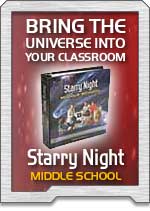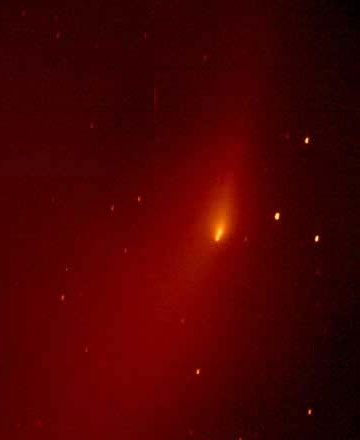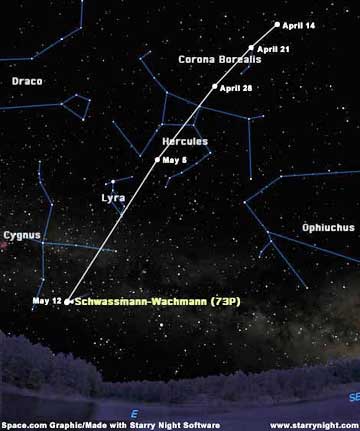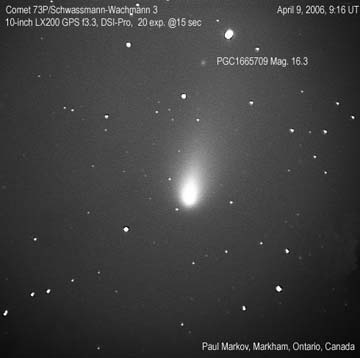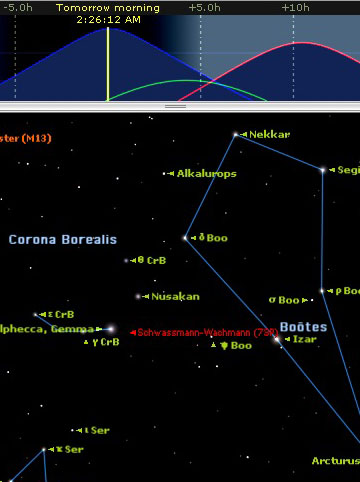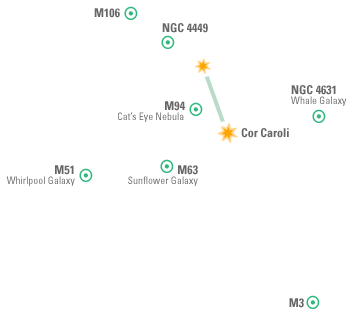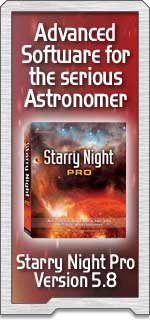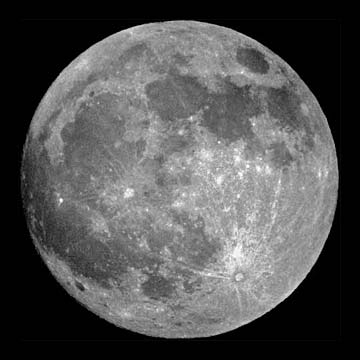 |
||||||||||||||||||||||||||||||||||||||||||||||||||||||||||||||||||||
|
If you have trouble viewing this newsletter, click here. Welcome again to our monthly newsletter with features on exciting celestial events, product reviews, tips & tricks, and a monthly sky calendar. We hope you enjoy it!
We would like to invite all astronomy clubs (or any other non-profit organization that promotes astronomy) to enter our Astronomy Day Contest by submitting a digital photograph that best exemplifies the spirit of Astronomy Day. The winning submission will receive a free copy of Starry Night Pro® 5 and will have the option of having their club profiled in the Starry Night® Times newsletter. All entries must be submitted electronically before May 30th, 2006. Please read the following guidelines and see the submission e-mail address below.
Pedro Braganca
All images taken by Jim Low Geoff Gaherty I traveled to the Total Eclipse of the Sun on March 29 with a group of 26 organized by Ralph Chou of the Toronto Centre of the Royal Astronomical Society of Canada (www.rasc.ca). Ralph decided to take the group to the Sahara Desert just south of the oasis town of Jalu because it had the best prospects for clear weather combined with a reasonable degree of accessibility. The trip included a week-long tour of Libya plus an optional week’s tour of Italy. After three days in Tripoli, where we visited two of the best-preserved Roman cities in the world, Sabratha and Leptis Magna, we traveled to Benghazi in eastern Libya. The day before the eclipse, we spent all day driving south into the desert, arriving at “Eclipse City” around 4 pm. This was a tent city setup for the thousands of visitors who came to Libya for the eclipse.
"Eclipse City" After a chaotic dinner, the only time the Libyan infrastructure really broke down, we retired early to our tents only to be awakened soon after by fireworks, loud music, and the roars of ATVs. For the Libyans, the eclipse had become something of a national holiday! Eclipse day dawned bright and clear, and was cool, as to be expected in the desert. As the Sun rose in the sky, the day became warmer. Soon, a narrow bite appeared in the limb of the Sun, as the Moon began to move across it. I had brought with me my Coronado Personal Solar Telescope, a 40mm refractor equipped with a narrow-band Hydrogen-Alpha filter in order to view solar prominences and detail on the Sun’s surface. This showed us that we were in for a treat: no fewer than eight prominences were arrayed around the limb of the Sun.
Geoff Gaherty catches some prominences with his Coronado Personal Solar Telescope. As the Sun was gradually covered by the Moon, the detail on its surface seemed to become more intense. Finally only the tiniest sliver remained, and I was treated to the unique sight of Baily’s Beads in Hydrogen-Alpha: a glittering necklace of glowing embers! With totality upon us, the Sun disappeared in the heavily filtered scope, and I switched to 10x50 binoculars to observe the total phase. As often occurs near solar minimum, the corona was quite compact but full of amazingly complex detail. Its whole shape was rather rectangular because of the arrangement of coronal streamers. From time to time I’d put the binoculars down and just take in the whole sight: the eclipsed Sun high in a very dark sky, with Venus obviously visible to its lower right, and the thousands of spectators arrayed around me in the desert floor, otherwise flat and apparently lifeless all the way to the distant horizon.
The planet Venus during totality. In my previous total eclipse trip I spent too much time on photography, so I had decided to take no photographs this time around and just use all my senses to observe the great event unfolding around me. Too soon (actually a little more than four minutes), the Diamond Ring flashed into view and the Moon began to move clear of the Sun, and soon we were back on the bus for the six-hour ride back to Benghazi. After a night there, we were off to Tripoli and then Rome for the Italian leg of the tour. I’d like to thank Ralph Chou of the Toronto Centre and Mahmood Poonja of Bestway Tours and Safaris for organizing and facilitating what was truly a once-in-a-lifetime experience. But even more, I’d like to thank the Libyan people, who were friendly and helpful everywhere we went. It was a special treat to “share the view” with many of them who drove down to the eclipse site for the day. Geoff Gaherty
Jim Low My colleague Geoff Gaherty and I traveled to Libya for the total solar eclipse on March 29. We observed from south of Jalu, in a totally remote area of the desert where all you could see to the horizon was sand and the tents set up at our site. There was no vegetation in sight. We traveled with a group organized by the Toronto Centre of the Royal Astronomical Society of Canada (www.rasc.ca), and joined up with several thousand others at the eclipse site.
I made temperature observations during the eclipse. During the morning, the temperature was rising, and reached a high of 30.5C at about 11:30AM local time, about 20 minutes after first contact. The temperature then gradually dropped to a low of 22.4C at about 12:45PM, about 15 minutes after totality, a total drop of about 8 degrees. I have recorded temperature changes at previous eclipses, and this was typical. There is always a lag in reaching the lowest point until after totality. Observations continued until after last contact, when the temperature reached 31.4 and was still rising when I was required to pack up to leave with my group.
Set up for temperature recording. This was my tenth total solar eclipse since I started the chases in 1963. I have also observed three annular eclipses and a number of partial eclipses. I regarded this eclipse as average in darkness. Venus was easily visible before and after totality. The entire horizon had the appearance of a sunrise/sunset glow at mid totality.
Totality Looking forward to chasing down number 11! Jim Low
The International Space Station (ISS) was in position to view the umbral (ground) shadow cast by the Moon as it moved between the Sun and the Earth during the solar eclipse on March 29, 2006.
This astronaut image captures the umbral shadow across southern Turkey, northern Cyprus, and the Mediterranean Sea. People living in these regions observed a total solar eclipse, in which the Moon completely covers the Sun’s disk. The astronaut photograph was taken at approximately 2:00 p.m. local time. The terminator of the eclipse—the line between the light and dark parts of the Sun’s disk— is visible as it passes across central Turkey. This total solar eclipse is the fourth to have occurred since 1999. The portion of the ISS visible at image top is the Space Station Remote Manipulator System. Credit: NASA
|
|
May 2006
|
||||||||||||||||||||||||||||||||||||||||||||||||||||||||||||||||||
|
The review highlights: “Starry Night® is a sky simulator and educational tool – and so much more. It provides students with such unique and compelling experiences that it is destined to change lives.”
NSTA Recommends KLIATT Maria O Arguello Linda Fung
|

|
|||||||||||||||||||||||||||||||||||||||||||||||||||||||||||||||||||
|
This comet, which will be well placed for observation this coming month, has a complicated name and a strange history. It was discovered photographically in 1930 by Arnold Schwassmann and Arno Arthur Wachmann of Hamburg Observatory in Germany. It was found to have a short period (hence the “73P” in its name) of roughly 5.4 years. It was a fairly small comet that was mainly interesting because its orbit brought it fairly close to Earth from time to time. During one of these close passages, in 1995, it broke up into four components, similar to the breakup of Comet Shoemaker-Levy 9. It has since continued to orbit as a string of fragments of varying size and brightness.
Comet 73P breaking up in 1995. Credit: Jim V. Scotti This comet, which most of us are calling S-W 3 for short, is once again well placed for observation, and will be readily visible for the next month. Fragment C, which is the largest of the fragments. Fragment B is also fairly large and bright; at least two more fragments are visible in telescopes if you know precisely where to look. The comet will be at its brightest around May 13, when it passes closest to the earth, 0.0735 Astronomical Units (11 million kilometres) away.
The positions of comet SW-3 at one-week intervals To find the comet in Starry Night®, click on the Find tab. Click on the magnifying glass in the “Find” box, and select “Orbiting Objects.” Then type the letters “sch” in the box and you will get the comets discovered by Schwassmann and Wachmann which are currently visible. The one you want is the second one, 73P. Click in the check box to the left of the name to turn on its label, and then click on the menu button further left and choose “Centre.” Set the time to the time you plan to observe (at present the comet is visible most of the night, though it’s gradually moving into the morning sky), zoom to an appropriate size, and print out a finder chart. As I write this, the C fragment is about 9th magnitude, and so is visible in binoculars in a dark sky. It will gradually increase in brightness as it approaches the Earth, though comet brightness predictions are generally hit and miss.
Image of Comet 73P/Schwassmann-Wachmann 3 Starry Night® Pro users can get a better idea of when the best time to observe the comet is by using the Graph Tool. Go back to the Find pane and click on the menu button beside the comets name. Select “Start Graphing.” A graph will appear at the top of the screen showing the altitude of the Sun (red), Moon (green), and the comet (blue) over time. The best time to observe is when the comet is highest, but when the Sun and Moon aren’t interfering with it.
Good luck comet hunters! For the latest news on the comet, please visit www.space.com. Geoff Gaherty
This part of the sky floats above the celestial north pole so there isn't a lot of interstellar dirt obscuring our lines of sight toward some interesting, though faint, galaxies. M51, the Whirlpool Galaxy, is a good example of quantity equaling quality: time spent with M51 reaps rewards, with brief flashes of clarity that slowly build in your mind's eye to a fascinating whole. Although faint, two cores are visible; the second, less bright core is that of NGC 5195, a smaller galaxy interacting gravitationally with its large neighbor. Get yourself as dark adapted as possible. Averted vision will bring out hints of the spiral arms. Some nights are better than others. M63 and M94 are two more spiral galaxies, less spectacular, but interesting to compare with each other and with M101 and M51. Cor Caroli is a nice double even in small scopes. Note the color difference. Cor Caroli has only 2.3 times the radius of our sun yet shines a hundred times as bright. NGC 4631 is also known, quite properly, as the Whale Galaxy. It's faint, huge, elongated and completely awesome in the eyepiece. NGC 4449 is an irregular galaxy in Canes Venatici. In comparison to the Whale, this galaxy is elongated, kinked, and a bit weird looking. Moving away from some of the fainter targets, M106 is a big galaxy with a bright disc. Easy hunting. Finally, with an estimated half-million stars, M3 is one of the sky's finest globular clusters. While visible to the naked eye, the more photons your telescope or binoculars can capture, the more stars you'll be able to resolve. Sean O'Dwyer
|

|
|||||||||||||||||||||||||||||||||||||||||||||||||||||||||||||||||||
|
Michel Hersen, Portland, Oregon Taken with a Tele Vue 102 refractor, Olympus C-5060 Digital Camera, and a 40 mm Scope Tronix Maxview Eyepiece. The ISO was 80 and the exposure 1/250th second. The eyepiece was attached to the camera with a Scope Tronix Bower.
PHOTO OF THE MONTH COMPETITION: We would like to invite all Starry Night® users to send their quality astronomy photographs to be considered for use in our monthly newsletter. Featured submissions (best of month) will receive a prize of $25 USD. Please read the following guidelines and see the submission e-mail address below.
|
||||||||||||||||||||||||||||||||||||||||||||||||||||||||||||||||||||
 |
||||||||||||||||||||||||||||||||||||||||||||||||||||||||||||||||||||
|
|
||||||||||||||||||||||||||||||||||||||||||||||||||||||||||||||||||||
You have received this e-mail as a trial user of Starry Night® Digital Download
or as a registrant at starrynight.com. To unsubscribe, click here.







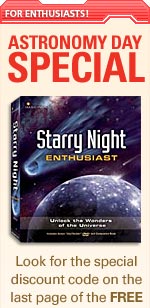

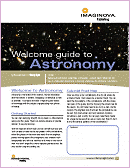

 Best Educational Software: Science
Best Educational Software: Science Best Instructional Solution: Science
Best Instructional Solution: Science